NOTE:
- Times shown are UT (universal time) unless noted otherwise. Solar North is up in all the near real time images.
IMAGE BROWSER
Launch the interactive browser to learn more about EIT and MDI images.
Credit: This browser was developed by Kristian Pontoppidan Larsen. He is an Applied Physics Engineer from Denmark and a SOHO fan who likes to develop web applications and study the connection between the sun, weather and climate.
LASCO IMAGES
 | 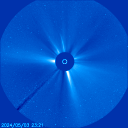 |
Images: LASCO C2 (left). LASCO C3 (right).
LASCO (Large Angle Spectrometric Coronagraph) is able to take images of the solar corona by blocking the light coming directly from the Sun with an occulter disk, creating an artificial eclipse within the instrument itself. The position of the solar disk is indicated in the images by the white circle. The most prominent feature of the corona are usually the coronal streamers, those nearly radial bands that can be seen both in C2 and C3. Occasionally, a coronal mass ejection can be seen being expelled away from the Sun and crossing the fields of view of both coronagraphs. The shadow crossing from the lower left corner to the center of the image is the support for the occulter disk.
C2 images show the inner solar corona up to 8.4 million kilometers (5.25 million miles) away from the Sun.
C3 images have a larger field of view: They encompass 32 diameters of the Sun. To put this in perspective, the diameter of the images is 45 million kilometers (about 30 million miles) at the distance of the Sun, or half of the diameter of the orbit of Mercury. Many bright stars can be seen behind the Sun.
NOTE: Observations are almost continuous but their immediate availability on the website depends on having telemetry contact with the spacecraft via DSN stations. When there is no telemetry downlink, observations are recorded on the spacecraft's solid state recorder. After the downlink becomes available, we receive the new observations and those stored in the recorder.
Once the data is downlinked, there is an automated process to post the images on our site in a web-friendly format (ex. JPG, GIF). It is common that "missing observations" appear at a later time. This is because we had to wait for the telemetry contact to download the stored data from the spacecraft. The data in The Very Latest SOHO images page is intended just for visual inspection, not analysis as it is not of science quality.
In some occasions, the images have data gaps caused by transmission errors. These data gaps appear as black blocks, superimposed on the images (see image below). They look particularly bad and distracting when we generate movies from these images. To mitigate this, the automated process posting images on our site identifies gaps and uses blocks from a previous image to replace the missing blocks in the new image.

Data gaps are often corrected upon re-transmission but this can take some time. As we are interested in making our data available immediately for viewing, we don't want to wait for the re-transmissions. However, the re-transmitted science quality data products are available via the SOHO Science Archive.
Visit SOHO Explore! to learn more about the Sun.
 | 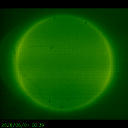 | 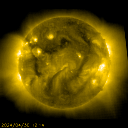 | 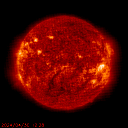 |
Images: From left to right: EIT 171, EIT 195, EIT 284, EIT 304
EIT (Extreme ultraviolet Imaging Telescope) images the solar atmosphere at several wavelengths, and therefore, shows solar material at different temperatures. In the images taken at 304 Angstrom the bright material is at 60,000 to 80,000 degrees Kelvin. In those taken at 171 Angstrom, at 1 million degrees. 195 Angstrom images correspond to about 1.5 million Kelvin, 284 Angstrom to 2 million degrees. The hotter the temperature, the higher you look in the solar atmosphere.
Visit SOHO Explore! to learn more about the Sun.
 | 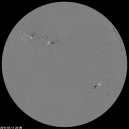 |
Images: MDI Continuum (left). MDI Magnetogram (right).
The MDI (Michelson Doppler Imager) images shown here are taken in the continuum near the Ni I 6768 Angstrom line. The most prominent features are the sunspots. This is very much how the Sun looks like in the visible range of the spectrum (for example, looking at it using special 'eclipse' glasses: Remember, do not ever look directly at the Sun!). The magnetogram image shows the magnetic field in the solar photosphere, with black and white indicating opposite polarities.
Visit SOHO Explore! to learn more about the Sun.


